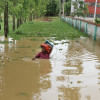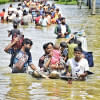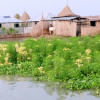Causes of Flood: Heavy rains, shallow rivers
The flood has hit Rangpur division the hardest as it rained in the region almost three times more than it had until this point last year.
So far, 4,327mm rainfall has been recorded in Rangpur division until Wednesday. There was only 1,745mm until July last year, according to the Bangladesh Meteorological Department.
Mymensingh, Sylhet, and Chattogram divisions also got more rain than they had last year.
As the rivers became shallow over the years due to siltation, heavy showers caused the water bodies to swell and flood vast areas.
“Basically, flash floods in Chattogram division and heavy showers in northern districts aggravated the flood situation. The country’s rivers could contain only one twelfth of the water that came from up-stream this year. The rest of the water caused the flood,” Shah Kamal, senior secretary to the Disaster Management and Relief Ministry, told The Daily Star.
Arifuzzaman Bhuyan, executive engineer of Bangladesh Water Development Board, said this year’s flood hit at least 12 districts at the same time.
“Flood usually hits Sylhet division and then gradually affects other parts of the country. But this year’s flood had affected the northern, Chattogram and Sylhet regions at the same time,” he said.
Kabir Bin Anwar, secretary of the Ministry of Water Resources, said, “Due to heavy siltation, rivers have become shallow, causing floods every year. We have taken a project of dredging 448 small rivers and canals. We hope that the flood situation will improve within the next three or four years.”
The office of the UN Resident Coordinator’s estimates that 5.3 million people were directly affected, 419,336 houses damaged, and 287,513 people were displaced in this year’s flood.
EROSION LOOMS
Meanwhile, experts said although flood waters would continue to recede in the next few days, rivers might start eroding their banks.
Gaibandha, Kurigram, Jamalpur, Rajbari, Shariatpur, and Faridpur are likely to be erosion affected, they said.
“Flood situation has started improving and we are hopeful that by August 3, the situation will be normal unless there are more heavy showers,” Arifuzzaman told The Daily Star.
Earlier this year, the Centre for Environmental and Geographic Information Services predicted erosion at 22 locations in 13 districts by the Padma and Jamuna rivers.
The report predicted that about 2,860 hectares, including 500 hectares of settlements, might be erod-ed.
It also predicted that 420 metres of embankments, 8km of roads, 35 educational institutes, five mar-kets, and five health care centres might be devoured by the rivers.
“Erosion will be worse than predicted, especially in Kurigram, Gaibandha, Jamalpur and Bogura,” said CEGIS Deputy Executive Director Maminul Haque Sarker.

 For all latest news, follow The Daily Star's Google News channel.
For all latest news, follow The Daily Star's Google News channel. 








Comments